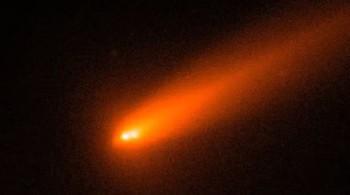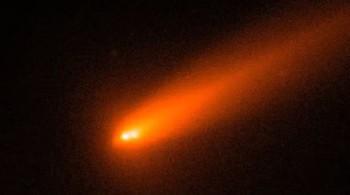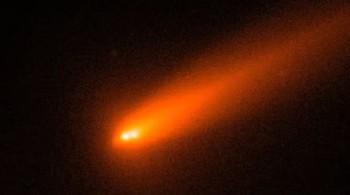
Comet C/2025 K1 (ATLAS) breaks into 3 after coming close to Sun
The fascinating world of astronomy has once again witnessed a rare and awe-inspiring event. Comet C/2025 K1 (ATLAS), a comet that was discovered earlier this year, has broken into three pieces after making a close approach to the Sun. This extraordinary occurrence was captured by astronomers using Italy’s Copernicus telescope, providing a unique glimpse into the comet’s dramatic transformation.
The comet’s close encounter with the Sun took place on October 8, and it was during this time that the comet’s nucleus became unstable. As a result, the comet broke apart, resulting in two large chunks and a smaller third piece. The two bigger fragments are estimated to be about 2,000 km apart, while the smaller piece is located to the left of the pair. This remarkable event is a testament to the dynamic and unpredictable nature of comets, which are often referred to as “dirty snowballs” due to their composition of ice, dust, and rocky particles.
Comet C/2025 K1 (ATLAS) was first discovered by the Asteroid Terrestrial-impact Last Alert System (ATLAS) in May 2025. Since then, astronomers have been closely monitoring the comet’s trajectory, anticipating its close approach to the Sun. The comet’s perihelion, or closest point to the Sun, occurred on October 8, when it passed within 1.3 astronomical units (AU) of the Sun. One astronomical unit is the average distance between the Earth and the Sun, which is approximately 149.6 million kilometers.
As the comet approached the Sun, it began to experience intense heat and radiation, causing its ices to vaporize and creating a bright coma around its nucleus. The coma is a cloud of gas and dust that surrounds the comet’s nucleus, and it is this phenomenon that makes comets visible to the naked eye. However, the intense heat and radiation from the Sun also took a toll on the comet’s structure, ultimately leading to its break-up.
The break-up of Comet C/2025 K1 (ATLAS) is not an unprecedented event. Comets are known to be fragile and prone to fragmentation, especially when they approach the Sun. The heat and radiation from the Sun can cause the comet’s ices to vaporize, leading to a build-up of pressure that can eventually cause the comet to break apart. This process is known as “thermal fracturing,” and it is thought to be responsible for the break-up of many comets throughout history.
The images of Comet C/2025 K1 (ATLAS) captured by the Copernicus telescope are truly stunning, providing a unique glimpse into the comet’s dramatic transformation. The two large chunks of the comet are visible, with the smaller third piece located to the left of the pair. The images also show the comet’s coma, which is still visible despite the break-up of the nucleus.
The break-up of Comet C/2025 K1 (ATLAS) is a significant event for astronomers, who are eager to study the comet’s fragments and gain a better understanding of the comet’s composition and structure. The comet’s fragments will continue to be monitored in the coming weeks and months, providing valuable insights into the comet’s evolution and behavior.
In conclusion, the break-up of Comet C/2025 K1 (ATLAS) is a remarkable event that highlights the dynamic and unpredictable nature of comets. The comet’s close approach to the Sun has provided a unique opportunity for astronomers to study the comet’s behavior and composition, and the images captured by the Copernicus telescope are a testament to the awe-inspiring beauty of the comet’s transformation.




